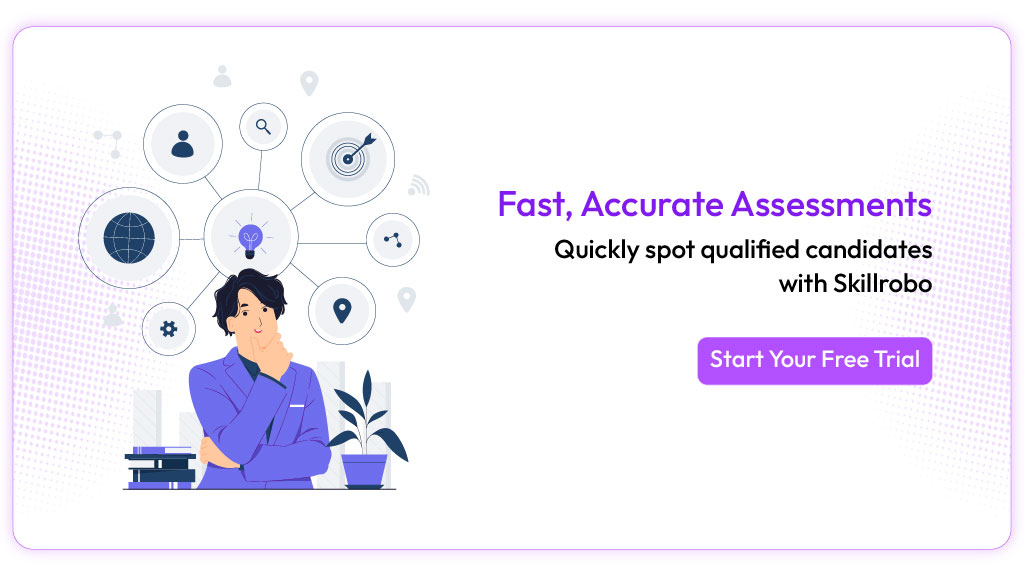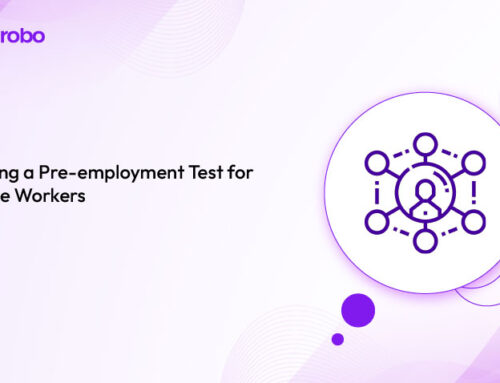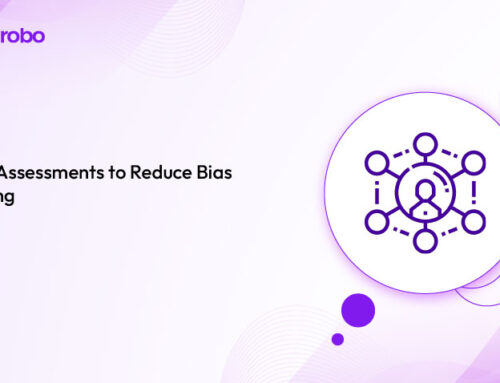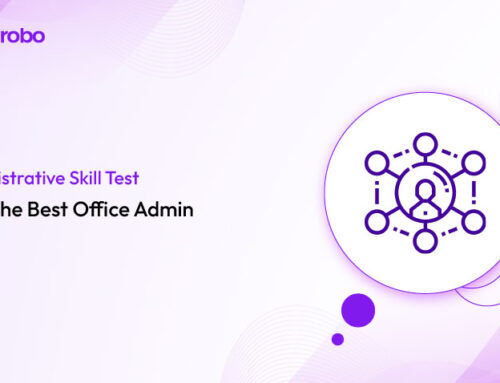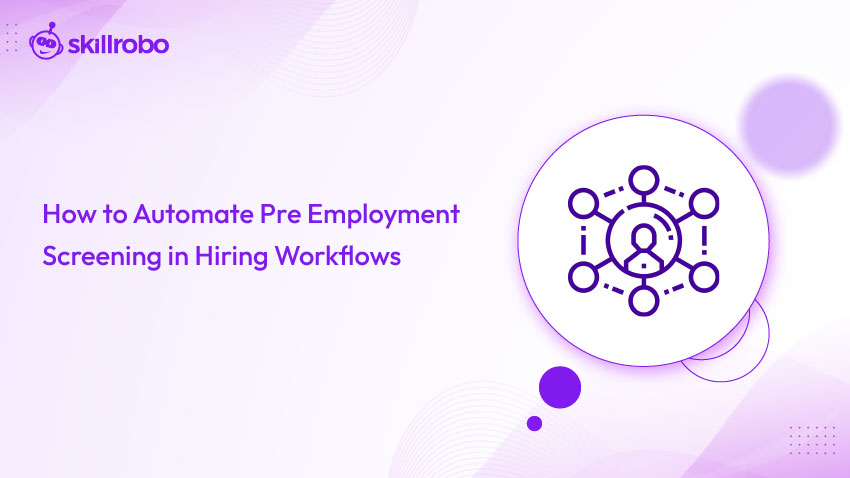
Key Takeaways
- Automating pre-employment screening reduces manual effort, enabling HR teams to focus on strategic hiring decisions and candidate engagement.
- Role-specific assessments streamline workflows by quickly identifying candidates with the precise skills needed for the job.
- AI-powered tools, like Skillrobo, enhance efficiency with real-time analytics and proctoring, ensuring fair and accurate evaluations.
- Integration of cognitive, behavioral, and leadership assessments into hiring processes improves candidate fit and long-term performance.
Automate Pre-Employment Screening in Hiring Workflows
Hiring the right talent is a critical task for HR professionals and hiring managers, yet traditional screening methods often bog down the process with time-consuming manual reviews and subjective judgments. Automation offers a smarter way forward, transforming recruitment into a streamlined, data-driven operation. By leveraging technology, companies can sift through applicant pools faster, reduce bias, and pinpoint candidates who truly align with role requirements. This shift is not just a trend—Organizations like Amazon and Deloitte have long embraced automated tools to optimize their talent acquisition, proving their value in competitive markets.
The challenge lies in balancing speed with quality. Manual resume screening can take hours, and interviews alone don’t always reveal a candidate’s full potential. Automation addresses these pain points by introducing efficiency and objectivity, allowing teams to focus on what matters: building a skilled workforce. In this blog, we’ll explore how to automate pre-employment screening within hiring workflows, with actionable strategies and insights tailored for HR professionals and hiring managers.
Why Automate Pre-Employment Screening?
The recruitment landscape has evolved, with organizations facing larger applicant volumes and tighter timelines. A study by the Society for Human Resource Management (SHRM) found that HR professionals spend up to 30% of their time on administrative tasks like screening resumes. Automation cuts through this inefficiency, replacing repetitive tasks with intelligent systems that deliver faster, more reliable results. Beyond time savings, it minimizes human error and ensures consistency—crucial factors when evaluating hundreds of candidates for a single role.
For example, companies like iCIMS, a U.S.-based talent cloud provider, report that automating screening processes can reduce time-to-hire by up to 20%. This isn’t just about speed; it’s about precision. Automated tools assess skills, behaviors, and aptitudes objectively, helping hiring teams avoid the pitfalls of gut-based decisions. Whether you’re hiring for technical roles or leadership positions, integrating automation into your workflow sets the stage for smarter talent acquisition.
Reducing Time-to-Hire with Automation
Time is a precious commodity in recruitment. The longer a position remains open, the more productivity and revenue a company risks losing. Automated pre-employment screening accelerates this process by filtering candidates based on predefined criteria, such as technical skills or experience levels. Tools like Skillrobo provide role-specific assessments that evaluate applicants in minutes, delivering instant insights to move the best fit forward.
Enhancing Objectivity and Fairness
Human bias can creep into manual screening, whether through favoring certain resumes or overlooking hidden talent. Automation levels the playing field. By relying on data-driven evaluations—such as assessments for cognitive abilities—teams can focus on measurable competencies rather than subjective impressions, aligning with fair hiring practices championed by organizations like the Equal Employment Opportunity Commission (EEOC).
Key Components of an Automated Screening Workflow
Building an effective automated screening process requires more than just software—it demands a strategic approach. The goal is to create a seamless workflow that integrates assessments, analytics, and monitoring into your existing hiring framework. This ensures candidates are evaluated holistically, from technical prowess to cultural fit, without overwhelming your team. Let’s break down the essential elements that make this possible, drawing from proven practices in the recruitment space.
Skillrobo has revolutionized hiring with AI-driven assessments. Their success stems from combining targeted evaluations with real-time data, a model that HR professionals can replicate. With the right components, your screening process can shift from a bottleneck to a competitive advantage.
Role-Specific Assessments
Not all roles demand the same skills. A software developer needs coding expertise, while a call center agent requires strong communication abilities. Automated tools should offer tailored evaluations, such as Skillrobo’s evaluations for call center roles, to match candidates to job demands precisely. This specificity reduces irrelevant applications and sharpens the focus on qualified talent.
Cognitive and Behavioral Evaluations
Skills alone don’t guarantee success—mindset and behavior matter too. Incorporating cognitive and personality assessments into your workflow reveals how candidates think, solve problems, and interact with teams. For instance, a leadership role might prioritize decision-making aptitude, while a collaborative position values emotional intelligence. These insights drive better long-term hires.
AI-Driven Question Creation
Crafting assessment questions manually is time-intensive and prone to inconsistency. AI steps in here, generating relevant, role-aligned questions efficiently. Skillrobo’s Seyarc AI, for example, focuses on question creation, ensuring evaluations stay current with industry standards. This feature saves HR teams hours while maintaining assessment quality.
Proctoring and Monitoring
Fairness in testing is non-negotiable. Automated proctoring, like Skillrobo’s Seyarc AI integration, monitors candidate activity during assessments, flagging irregularities without human oversight. This ensures authenticity in remote hiring—a growing necessity in today’s distributed workforce.
Real-Time Analytics and Reporting
Data turns screening into a science. Real-time analytics provide instant visibility into candidate performance, from test scores to behavioral trends. Skillrobo’s reporting tools deliver actionable insights, enabling hiring managers to compare applicants and make informed decisions quickly. This mirrors the data-driven approach of talent platforms like LinkedIn, where metrics guide strategy.
Steps to Implement Automation in Your Hiring Workflow
Transitioning to an automated screening process doesn’t happen overnight—it requires planning and execution. The good news? With the right steps, HR teams can integrate tools seamlessly, minimizing disruption while maximizing impact. Below, we outline a practical roadmap, grounded in strategies to help you automate effectively.
Companies like Google have long automated parts of their hiring, using structured workflows to handle massive applicant pools. While your organization may not operate at that scale, the principles—clarity, integration, and iteration—apply universally.
Step 1 – Define Your Screening Goals
Start with clarity: What do you want automation to achieve? Reducing time-to-hire, improving candidate quality, or eliminating bias? Pinpointing goals shape your tool selection and workflow design. For example, if hiring for administrative roles, prioritize evaluations for clerical skills to target relevant competencies.
Step 2 – Choose the Right Tool
Not all automation platforms are equal. Look for solutions offering flexibility, such as customizable assessments, and robust analytics. Skillrobo stands out with its AI-powered features and competency assessments, aligning with diverse hiring needs across industries.
Step 3 – Integrate with Existing Systems
Your hiring tech stack—ATS, HRIS, or CRM—should work in harmony with automation tools. Seamless integration ensures candidate data flows effortlessly, avoiding silos. Skillrobo’s compatibility with applicant tracking systems exemplifies this, streamlining workflows from application to onboarding.
Step 4 – Test and Refine the Process
Launch a pilot program with a small batch of roles. Monitor outcomes—did time-to-hire drop? Are hires performing better? Use feedback to tweak assessments or adjust thresholds. This iterative approach, endorsed by Workflow86, ensures continuous improvement.
Step 5 – Train Your Team
Automation doesn’t replace HR—it empowers it. Train your team on interpreting analytics, managing proctoring, and leveraging insights. A well-equipped staff maximizes the tool’s potential, turning data into hiring wins.
Benefits of Automating Pre-Employment Screening
The payoff of automation extends beyond efficiency—it reshapes how organizations attract and retain talent. By shifting focus from manual tasks to strategic decision-making, HR teams unlock measurable advantages. These benefits, seen in real-world applications by firms like Deloitte, underscore why automation is a game-changer for modern recruitment.
Cost Savings and Scalability
Manual screening drains resources, especially for high-volume hiring. Automation cuts costs by reducing hours spent on reviews and interviews. Skillrobo’s scalable design supports mass hiring, making it ideal for growing businesses or seasonal spikes.
Improved Candidate Experience
A slow, opaque process frustrates applicants. Automated screening delivers quick feedback and clear next steps, enhancing perceptions of your employer brand. This aligns with findings from Hirebee.ai, which note that streamlined workflows boost candidate satisfaction.
Data-Driven Decisions
Gut feelings can lead to bad hires. Automation provides objective data—scores, trends, and comparisons—empowering managers to choose confidently. Skillrobo’s real-time reporting exemplifies this, offering clarity at every stage.
Conclusion
Automating pre-employment screening transforms hiring from a labor-intensive chore into a strategic advantage. By integrating role-specific assessments, AI-driven tools, and real-time analytics, HR professionals and hiring managers can identify top talent faster and more accurately. Skillrobo simplifies this shift, offering features like customizable evaluations, proctoring via Seyarc AI, and instant reporting to streamline workflows. Ready to optimize your hiring process?
Sign up for Skillrobo today and experience how automation delivers efficiency, fairness, and precision to your recruitment strategy.

